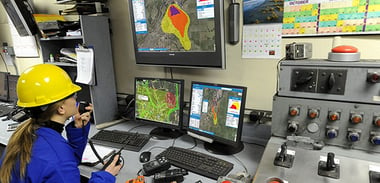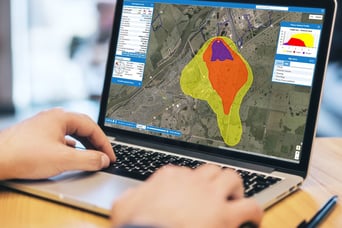 In the realm of industrial safety and environmental protection, the adage "an ounce of prevention is worth a pound of cure" has never rung truer. Today's industrial landscape is a complex web of activities where the potential release of hazardous materials poses not only a threat to worker safety but also to the surrounding communities and the environment at large.
In the realm of industrial safety and environmental protection, the adage "an ounce of prevention is worth a pound of cure" has never rung truer. Today's industrial landscape is a complex web of activities where the potential release of hazardous materials poses not only a threat to worker safety but also to the surrounding communities and the environment at large.
Looking at past incidents – such as when a plant-wide power outage in Texas forced a plant to flare off product (including sulfur dioxide) that then drifted into local communities and caused a partial shutdown to the area or when a train carrying five rail cars worth of vinyl chloride derailed last year – we’re reminded that the unexpected can strike our local environments with little warning.
Following an unexpected incident, a trail of questions and uncertainties are often in its wake: What’s happening on the ground? What gas is being released? How much was released and where? Will employees, responders, and community members be exposed to dangerous levels of gas? How will this impact our local environment?
Despite this, having an operational readiness model in place is the best way to answer these questions, and how you prepare for and respond to these emergencies is a testament to your commitment to both the environment and public safety.
Operational Readiness: Our Shield Against the Unforeseen
Operational readiness is not merely a concept; it is our proactive shield against the unforeseen, a comprehensive model that weaves together the threads of preparedness, situational awareness, and swift action.
At its core, operational readiness is about creating a framework that readies us for worst-case scenarios while bolstering our daily operations against the more common risks that lurk in the shadows of routine industrial processes.
A sound operational readiness plan is characterized by its dynamic nature, able to adapt to evolving threats with agility and informed precision. It demands a common operating picture – a unified vision that guides all stakeholders, from safety managers to first responders, in making decisions that are both quick and sound. In an emergency, this common picture becomes the linchpin of effective communication and coordinated action.
A Chemical Emergency Toolkit: A Safety Manager's Best Ally
 Integral to operational readiness is a chemical emergency toolkit, a collection of strategies and tools designed to address the myriad challenges that a chemical emergency presents. This toolkit is the embodiment of the operational readiness model, a tangible set of resources that enable rapid response, facilitate environmental impact assessments, and most importantly, protect human health.
Integral to operational readiness is a chemical emergency toolkit, a collection of strategies and tools designed to address the myriad challenges that a chemical emergency presents. This toolkit is the embodiment of the operational readiness model, a tangible set of resources that enable rapid response, facilitate environmental impact assessments, and most importantly, protect human health.
Key components of this toolkit include personal gas monitors, which serve as the first line of defense for individual workers, and area monitors, which cast a wider net of surveillance, establishing perimeters, and offering remote insights into unfolding emergencies.
When complemented by real-time weather data and dynamic plume modeling software, such as SAFER One, these tools empower safety leaders with predictive capabilities, allowing them to anticipate the path of airborne hazards and enact preemptive measures.
From Reactive to Proactive
Operational readiness urges us to move from a reactive stance to a proactive one. It's not enough to respond to emergencies; we must anticipate and prevent them.
This proactive approach is not only crucial during large-scale events but is equally vital in our day-to-day operations. Regular emergency drills, strategic placement of monitoring equipment, and predictive modeling become routine practices that embed safety into the DNA of our operations.
Consider the scenario of a planned facility turnaround, a period marked by heightened risk. By running plume models in advance, safety managers can identify areas that are more likely to be impacted by a potential leak or fire and ensure it won’t impact their local communities or environment.
Area monitors, meanwhile, can then be strategically deployed to ensure early detection and response, mitigating the need for workers to enter hazardous zones. This proactive planning is the cornerstone of a robust operational readiness model, transforming potential crises into manageable events.
Expanding the Reach of Safety
Beyond the confines of industrial sites lies the broader community, a critical stakeholder in any operational readiness plan. Community involvement means extending the protective reach of your safety models to those who reside in the shadow of industrial operations. Clear communication plans, shelter-in-place training, and a transparent approach to emergency preparedness are essential in assuring residents that their safety is a paramount concern.
The Cost of Unpreparedness: A Price Too High
 The stakes of unpreparedness are high, with the potential for severe environmental damage, loss of human life, and crippling financial losses. Incidents involving hazardous materials can incur costs upwards of hundreds of thousands per day, not to mention the long-term reputational damage to the responsible organization.
The stakes of unpreparedness are high, with the potential for severe environmental damage, loss of human life, and crippling financial losses. Incidents involving hazardous materials can incur costs upwards of hundreds of thousands per day, not to mention the long-term reputational damage to the responsible organization.
An effective operational readiness model is not just a regulatory requirement or a moral obligation – it is a sound business strategy that safeguards against the financial ruin that often accompanies environmental disasters.
Environmental Protection Needs Operational Readiness
The action today's industrial operators need to take is clear: Embrace operational readiness as the new standard in environmental protection and monitoring. It is an investment in the future – a future where the health and safety of workers, residents, and ecosystems are inextricably linked to the success of our industrial endeavors.
Through the lens of recent events, we are reminded of the imperative to remain vigilant, to continually refine our readiness models, and to harness the power of technology in our quest for a safer and more sustainable world. Let us forge ahead with the understanding that in the intricate balance of industrial progress and environmental conservation, preparedness is not just an advantage – it is our duty.



